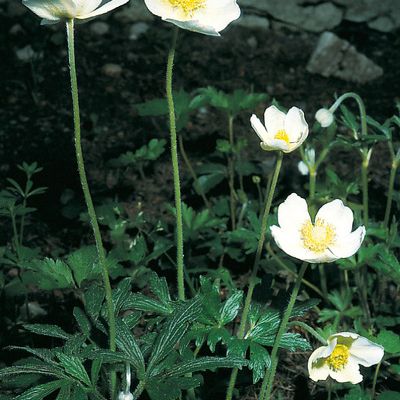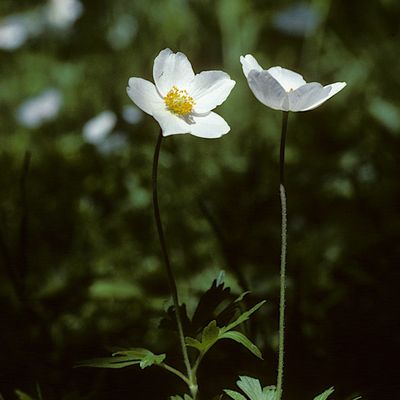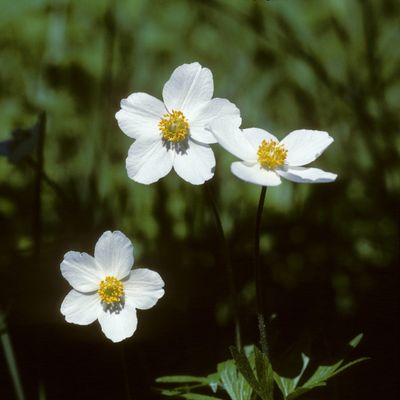Anemone sylvestris L.
1003790
Species
ISFS : 33800
Checklist : 1003790
ISFS : 33800
Checklist : 1003790
Contains :
Synthesis
Species description (© Flora Helvetica 2018)
20-40 cm hoch. Grundständige Blätter 3- oder 5teilig, mit 2- oder 3teiligen, vorn grob gezähnten Abschnitten. Stängel meist unterhalb der Mitte mit einem Quirl von ähnlich geformten, gestielten Hochblättern. Blüten meist einzeln, weiss, Durchmesser 4-7 cm, mit 5-6 aussen lang behaarten Blumenblättern, auf dicht behaartem Stiel. Früchtchen lang behaart, Griffel nach der Blüte nicht verlängert.Flowering period (© Flora Helvetica 2018)
4-5Habitat and distribution inside Switzerland (© Flora Helvetica 2018)
Trockenwarme Hügel / kollin(-montan) / SHWorld distribution (© Flora Helvetica 2018)
EurosibirischEcological indicator (© Landolt & al. 2010)
253-44+5.h.2n=16,32Status
IUCN status
Critically endangeredNational Priority
2 - high national priorityInternational responsibility
1 - weakConservation
Threats
Intensivierung der Landwirtschaft oder fehlende Nutzung
Beweidung
Verbuschung/Eutrophierung
Zuwachsen Waldbiotope
Tritt, Bauten und Tourismus
Sammeln, Ausgraben
Wenige, isolierte Populationen
Distribution map
Habitat and distribution inside Switzerland
SHWorld distribution
EurosibirischEcology
Life form
Perennial hemicryptophyte
Habitats
Milieux Phytosuisse (© Prunier et al. 2017)
Habitats © Delarze & al. 2015
 | 5.1.1 - Trockenwarmer Krautsaum (Geranion sanguinei) |
bold
Dominant species, influencing the appearance of the habitat
 Character species
Character species
 Less strictly linked to a specific habitat
Less strictly linked to a specific habitat
Ecological indicator values by © Landolt & al. (2010)
| Soil factors | Climatic factors | Salinity tolerance | |||
|---|---|---|---|---|---|
| Humidity Value H | 2 | Light Value L | 4 | Salinity Index | -- |
| Reaction Value R | 5 | Temperature factor T | 4+ | ||
| Nutriments value N | 3 | Continentality K | 5 | ||
- Ecological values legend
Humidity Value H 1 very dry 1+ dry 2 moderatly dry 2+ moist 3 medium wet 3+ wet 4 very wet 4+ soggy 5 submerged or underwater f plants living in running water u mostly submerged plants v partly submerged, partly floating plants w humidity moderately variable (± scale of 1-2) w+ highly variable humidity (scale exceeding ± 2) Reaction Value R 1 Very acid (pH 2.5-5.5) 2 acid (pH 3.5-6.5) 3 lightly acid to neutral (pH 4.5-7.5) 4 neutral to basic (pH 5.5-8.5) 5 basic (pH 6-5 -> 8.5 Nutriments value N 1 very low in nutrients 2 low in nutriments 3 medium-poor to medium-rich in nutrients 4 rich in nutriments 5 very rich in nutriments Salinity tolerance 1 halotolerant 3 halophyle Light Value L 1 very shady 2 shady 3 lighted areas 4 luminous 5 highly luminous Temperature factor T 1 alpine to nival stages (from the treeline to the snowline) 1+ suprasubalpine and upper subalpine levels (pine and larch forests) 2 subalpine level (coniferous forests without beeches up to the upper limit of spruces) 2+ lower subalpine and upper mountain stages 3 mountain level (beech and silver fir forests, in the central Alps Scots pine forests) 3+ lower mountain and upper hill levels 4 hill level (mixed deciduous oak forests) 4+ hot places, hill level 5 very hot places, hill level (only in the hottest places, typical of southern Europe) Continentality K 1 Atlantic (high air humidity, very low temperature variations, mild winters) 2 Sub-Atlantic (high air humidity, low temperature variations, relatively mild winters) 3 sub-Atlantic to subcontinental (average air humidity, moderately variable temperature, slightly low winter temperatures) 4 subcontinental (low air humidity, large temperature variations, rather cold winters) 5 continental (very low air humidity, very large temperature variations, cold winters)
Water dependency
| Rivers | 0 - No link |
| Calm water | 0 - No link |
| Ground water | 0 - No link |
Nomenclature
Accepted Name (Checklist 2017)
Anemone sylvestris L.
Vernacular name
Deutscher Name :
Hügel-Windröschen, Hügel-AnemoneNom français :
Anémone des forêtsNome italiano :
Anemone silvestreMatch with other reference books
| Relation | Nom | Book | No |
|---|---|---|---|
| = | Anemone sylvestris L. | Checklist 2017 | 33800 |
| = | Anemone sylvestris L. | Flora Helvetica 2001 | 153 |
| = | Anemone sylvestris L. | Flora Helvetica 2012 | 143 |
| = | Anemone sylvestris L. | Flora Helvetica 2018 | 143 |
| = | Anemone sylvestris L. | Index synonymique 1996 | 33800 |
| = | Anemone sylvestris L. | Landolt 1977 | 1141 |
| = | Anemone sylvestris L. | Landolt 1991 | 986 |
| = | Anemone sylvestris L. | SISF/ISFS 2 | 33800 |
| = | Anemone sylvestris L. | Welten & Sutter 1982 | 371 |
= The taxon corresponds to the accepted taxon (Checklist 2017)
< The taxon is included in the accepted taxon (Checklist 2017)
> The taxon includes (among others) also the accepted taxon (Checklist 2017)
< The taxon is included in the accepted taxon (Checklist 2017)
> The taxon includes (among others) also the accepted taxon (Checklist 2017)
Status
Native status
-IUCN list of endangered species (© Walter & Gillett 1997) : No
Status on national Red List 2016
IUCN status:
Critically endangered

Additional information
IUCN criteria: B1ab(iii); B2ab(iii)
Status on regional Red List 2019
| Biogregraphic regions | Status | IUCN criteria |
|---|---|---|
| Jura (JU) | CR | B2ab(iii) |
| Mittelland (MP) | RE | |
| Alpennordflanke (NA) | NA | |
| Alpensüdflanke (SA) | -- | |
| Östliche Zentralalpen (EA) | -- | |
| Westliche Zentralalpen (WA) | NA |
- Legend
EX Extinct RE Regionally Extinct CR(PE) Critically Endangered, Probably Extinct CR Critically Endangered EN Endangered VU Vulnerable NT Near Threatened LC Least Concern DD Data Deficient NE Not Evaluated NA Not Applicable
National Priority Species List Status
| National Priority | 2 - high national priority |
| Need to take action | 2 - |
| International responsibility | 1 - weak |
| Need to monitor populations | 2 - |
Protection status
| International (Bern Convention) | No | |
| Cantonal | -- | |
| Switzerland | total protection |
- Disclaimer
InfoFlora compiles information on protected species as accurately as possible, taking it from the respective cantonal laws. In some cases, however, it was not possible to use the plant names as listed in the original text, but an interpretation of their taxonomy or nomenclature was necessary. The exact meaning of the categories „completely protected“ and „partially protected“ differs among the cantons.
InfoFlora cannot guarantee that the information on the protection status is correct and complete. In case of doubts, we recommend to look up the texts of the respective cantonal law.
Status by sector of activity
| Agriculture-related environmental objectives : | Z - | more informations |
| Forest management environmental objectives : | Z - | more informations |
Conservation
Threats and measures
Intensivierung der Landwirtschaft oder fehlende Nutzung
Extensive, späte Mahd (ab September), sofern nährstoffarm alle 2 bis 3 Jahre, regelmässige Entbuschung
Beweidung
Beweidung scheint in jedem Fall ungünstig. Wenn nicht auf Beweidung verzichtet werden kann, Bestände grosszügig auszäunen.
Verbuschung/Eutrophierung
Schnittgut (Streue, Äste) entfernen, damit ein magerer Saum entsteht.
Zuwachsen Waldbiotope
Wald sehr offen halten (stark entbuschen), Gehölze mit persistenter Laubstreue stark reduzieren, Föhren erhalten.
Tritt, Bauten und Tourismus
Information des Hüttenwartes der SAC-Hütte und der Sektion
Sammeln, Ausgraben
Information der Bevölkerung über geschützte Arten
evtl. saisonale Überwachung durch Kontrollorgane
Wenige, isolierte Populationen
Schutz (Mikroreservate) und regelmässige Bestandeskontrollen
Dauerflächen-Beobachtung
ex-situ-Vermehrung in Botanischen Gärten für Wiederansiedlungen in Reservaten im Randen
Erfolgskontrolle der Massnahmen gewährleisten.
Neuschaffung von aufnahmefähigen Biotopen in der Nähe des Verbreitungsgebietes durch Bodenabtrag. Neuansiedlung.


